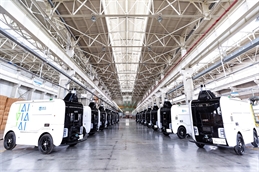
Alibaba Group revealed that it designing self-driving delivery trucks in collaboration with its logistics arm, Cainiao Network, which will follow the same technical framework in its autonomous delivery robots which just reached a milestone of delivering more than a million parcels in China within one year of their launch.
“These larger robots will be able to deliver goods at a faster speed and for longer distances. They are likely to appear on public roads within three years,” said Wang Gang, head of the Autonomous Driving Lab at DAMO Academy, which is Alibaba’s global research arm.
In a statement, Alibaba said each of its autonomous robots, dubbed Xiaomanlv can carry about 50 packages at a time and cover 100 kilometers on a single charge, delivering about 500 boxes per day.
In a show of efficiency, just 200 of the robots have carried parcels to more than 200,000 consumers in 52 cities across 22 Chinese provinces.
10,000 robots in 3 years
Over the next three years, Alibaba expects to expand the fleet from 200 robots to 10,000 robots, which equates to handling an average of 1 million packages a day.
Gang noted that advanced self-driving technology has increasingly become part of people’s daily lives.
“Xiaomanlv achieving over one million delivery orders is just the beginning,” said Wang. “It’s laid the groundwork for the future development and application of our autonomous driving technology.”
Alibaba’s venture into autonomous driving technology dates back to 2015 when the e-commerce giant sought to address last-mile delivery challenges as online shopping grew in popularity.
“One important breakthrough is our ability to use advanced algorithms to achieve a low-cost, mass deployment of our self-driving vehicles across communities and campuses,” Wang added.
He said the overall costs of producing and operating Xiaomanlv is a third of the industry average.
Wang added that the robot typically encounters more than 40 million obstacles each day but it can navigate its way more than 99.9% of the time without human intervention.



